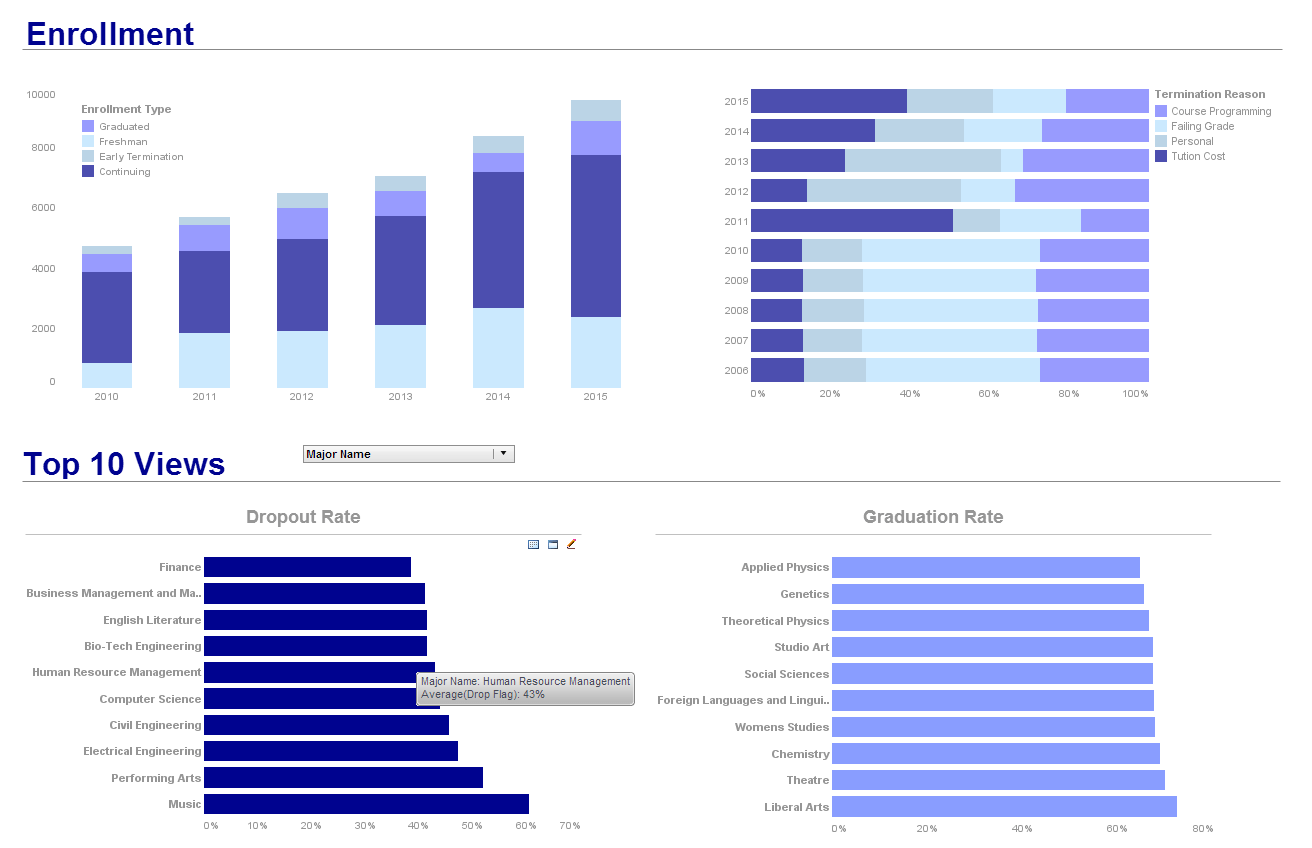Searching for a University Dashboard Reporting System?
 |
Looking to compare and monitor student performance and effectiveness of the educational process? |
 |
Do you want a business intelligence solution that is flexible enough to use in an educational setting? |
 |
InetSoft offers a small-footprint, full-featured BI platform that is easy to deploy and use. The single Web-based application provides a streamlined, intuitive interface for all users, teachers and administrators alike. |
 |
As an innovator in reporting software since 1996, InetSoft has pioneered the evolution from static reporting towards interactive visualization of data via dashboards |
Why InetSoft?
InetSoft's performance dashboard application is easy enough to be:- Deployed in just weeks
- Learned by end users with minimal training
- Used by any executive without the aid of IT
- Adaptable to changing data and business needs
- Used for data exploration through visualization
- Capable of maximum self-service
- Attract the attention of executives
- Meet the demands of power users
- Scale up for organizations of any size
Evaluate StyleBI from InetSoft. It's Easy. Agile. & Robust.
Register for more info and to download free eval software
What KPIs and Metrics Does a University Provost Use?
The role of a university provost is multifaceted, encompassing academic leadership, strategic planning, and operational oversight. To effectively fulfill their responsibilities, provosts rely on a variety of key performance indicators (KPIs) and metrics to assess the health and success of the institution across different areas. Here are some KPIs and metrics commonly used by university provosts:
-
Student Enrollment and Retention Rates: Tracking the number of enrolled students, as well as retention rates from year to year, helps provosts gauge the attractiveness and competitiveness of their academic programs. Higher enrollment and retention rates generally indicate student satisfaction and academic quality.
-
Graduation and Completion Rates: Monitoring graduation rates and time-to-degree metrics provides insight into the effectiveness of academic advising, support services, and curriculum design. Improving graduation rates enhances the institution's reputation and contributes to student success.
-
Faculty Productivity and Research Output: Provosts often track metrics related to faculty performance, such as research publications, grant funding, and teaching evaluations. These metrics help assess faculty productivity, academic impact, and contributions to the university's research mission.
-
Financial Performance: Financial metrics such as revenue, expenses, endowment size, and operating surplus or deficit are crucial for assessing the institution's financial health and sustainability. Provosts need to ensure that academic programs are adequately funded while maintaining fiscal responsibility.
-
Academic Program Quality and Accreditation: Monitoring metrics related to academic program accreditation, licensure exam pass rates, and rankings helps provosts evaluate program quality and competitiveness. Accreditation status and rankings can influence student enrollment and institutional reputation.
-
Student Satisfaction and Engagement: Surveys and feedback mechanisms are used to assess student satisfaction with academic programs, support services, and campus life. Provosts analyze these metrics to identify areas where enhancements are needed to improve the student experience.
-
Employment Outcomes: Tracking metrics related to post-graduation employment rates, salaries, and alumni success helps evaluate the effectiveness of academic programs in preparing students for careers. Positive employment outcomes contribute to the perceived value of a university education.
-
Facilities and Infrastructure: Monitoring metrics related to campus facilities, technology infrastructure, and maintenance helps ensure that the physical environment supports teaching, learning, and research activities effectively.
-
Community Engagement and Outreach: Metrics related to partnerships with local communities, industry collaborations, and public service initiatives are important for assessing the university's impact beyond campus boundaries.
More Articles About Dashboard Systems
Audience Demographics Dashboard - It's essential to comprehend your audience's demographics in order to customize digital experiences. DXPs provide information on the traits of people that visit your website: Geographic Location: You may more successfully target content and promotions by knowing where your audience is situated...
Career Services Director Balanced Scorecard - A career services director, responsible for assisting students and alumni in their career development and job placement, may include various charts on their balanced scorecard to track and measure the performance of their department. Here are some charts that a career services director might include: Job Placement Rate by Graduation Year: This chart would show the percentage of graduates who secure employment within a specified timeframe after graduation. It helps assess the effectiveness of the career services department in connecting students with job opportunities...
Lending Assessment Accuracy Dashboard - Experts agree that leading assessment is something that analytics can really help credit unions with."BI solutions are often based on machine learning algorithms whose purpose is to find patterns in data. This makes them a suitable option for credit unions," says Tim Dawson, a data science researcher at Studyker. "One major use case is to improve profitability and lending assessment accuracy...
Portfolio Diversification Dashboard - By distributing assets across several asset classes, a well-diversified portfolio reduces risk. This KPI evaluates the distribution of assets and makes sure the business doesn't specialize too much on one industry, minimizing the effect of market volatility on performance as a whole...



